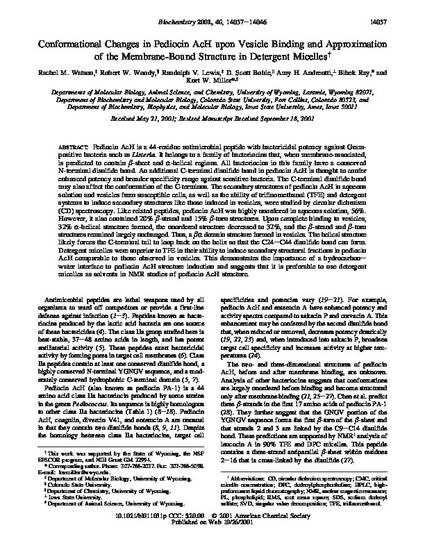
Pediocin AcH is a 44-residue antimicrobial peptide with bactericidal potency against Gram-positive bacteria such as Listeria. It belongs to a family of bacteriocins that, when membrane-associated, is predicted to contain β-sheet and α-helical regions. All bacteriocins in this family have a conserved N-terminal disulfide bond. An additional C-terminal disulfide bond in pediocin AcH is thought to confer enhanced potency and broader specificity range against sensitive bacteria. The C-terminal disulfide bond may also affect the conformation of the C-terminus. The secondary structures of pediocin AcH in aqueous solution and vesicles from susceptible cells, as well as the ability of trifluoroethanol (TFE) and detergent systems to induce secondary structures like those induced in vesicles, were studied by circular dichroism (CD) spectroscopy. Like related peptides, pediocin AcH was highly unordered in aqueous solution, 56%. However, it also contained 20% β-strand and 15% β-turn structures. Upon complete binding to vesicles, 32% α-helical structure formed, the unordered structure decreased to 32%, and the β-strand and β-turn structures remained largely unchanged. Thus, a βα domain structure formed in vesicles. The helical structure likely forces the C-terminal tail to loop back on the helix so that the C24−C44 disulfide bond can form. Detergent micelles were superior to TFE in their ability to induce secondary structural fractions in pediocin AcH comparable to those observed in vesicles. This demonstrates the importance of a hydrocarbon−water interface to pediocin AcH structure induction and suggests that it is preferable to use detergent micelles as solvents in NMR studies of pediocin AcH structure.
Available at: http://works.bepress.com/amy_andreotti/3/

Reprinted (adapted) with permission from Biochemistry 40 (2001): 14037, doi:10.1021/bi011031p. Copyright 2001 American Chemical Society.